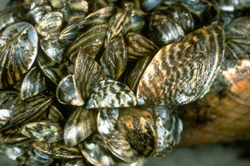This site contains educational materials from New
York Sea Grant on Aquatic Invasive Species. Also available on this site are informational materials
pertaining in a more general way to invasive species and invasive  species
introduction, control and management, policies, and research.
Information on this site is applicable to Great Lakes, inland, and
marine resource users and decision makers.
species
introduction, control and management, policies, and research.
Information on this site is applicable to Great Lakes, inland, and
marine resource users and decision makers.
Also provided is a "Relates Sites" section with links to Web sites of the National Aquatic Nuisance Species Clearinghouse and
other Sea Grant, federal, state, local and non-governmental organization
invasive species programs. Use the navigation bar at the left to access
information about Great Lakes Invasive Species, Zebra and Quagga Mussels, Aquatic Invasive Plants, Aquatic Invasive Animals, and Invasive Species Policies (New York State and U.S.).
Background
Hundreds of non-native organisms have been introduced to the Great Lakes and the lands around them by natural and human-mediated mechanisms (pdf).
It is also possible for some species to be introduced into a new
habitat through such natural means as inter-basin flooding and by
swimming from one water body to another.
These species run the gamut from
plants, such as purple loosestrife and poison hemlock, to familiar
animals, such as common carp and zebra mussels, to pathogens, such as
“whirling” disease, which impact native and non-native organisms alike.
These non-native species have caused dramatic changes to the Great Lakes
Basin ecosystem. These organisms are referred to by many names: invasive
species, non-native or non-indigenous species, aquatic nuisance species,
and exotic species.
On this Web site, “non-indigenous” and “non-native” are synonymous, as those species that have been transported by human
activities – intentionally or unintentionally – into a region in which
they did not occur in historical time and that are now reproducing in
the wild.
We use the term “invasive species” (pdf)
as meaning “. . . an alien [non-native] species whose introduction does
or is likely to cause economic or environmental harm or harm to human
health” [Ex. Order 13112, Pres. William Clinton (pdf)].
Non-native is not synonymous with invasive, the latter involving an
element of harm not necessarily implied in the former. To be included in
this website, a non-native species must be reproducing in
self-sustaining populations in their new Great Lakes environment.
Aquatic invasive species are often referred to as “aquatic nuisance
species.” Many non-native species have beneficial impacts on our society
and are not invasive.